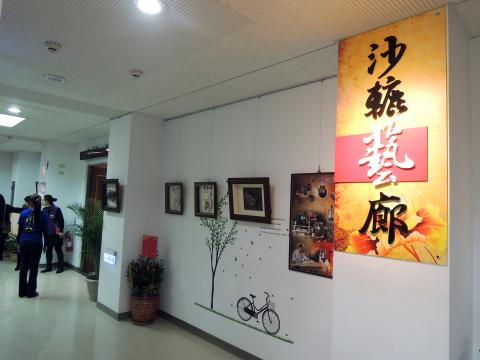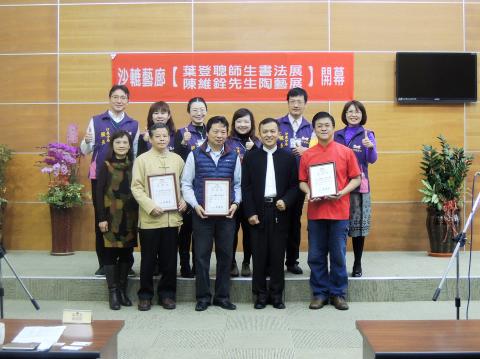Taichung City Government Local Tax Bureau’s Shalu Branch has turned a space in its office building into an art gallery and named it Shalu Gallery. Its opening exhibition features calligraphy and ceramic works by calligrapher Yeh Teng-tsung and ceramic artist Chen Wei-chuan. The exhibition runs till the end of May, and is open during the office’s work hours. On Mar. 16, its opening event attracted more than 70 students from Tunghai University’s Department of Public Management and Policy. By launching an art exhibition, the Shalu Branch is breaking stereotypes about government agencies.
The calligraphy works were provided by the calligraphy studio where Yeh teaches and a calligraphy class at a public library in Fengyuan. The featured calligraphers span a wide range of ages: some are young, some are middle-aged, and some are senior. Their works marry calligraphy with classical Chinese poetry, and are fascinating to look at. The ceramic works, on the other hand, are provided by Chen, who chooses fish as his main theme. His featured works, which include fish-shaped lights and a fish mural in ceramic, are all masterpieces.
The Local Tax Bureau Deputy Director-general Yeh Kuo-chu says Shalu has been a center of culture, though public exhibition space is still lacking. Local artists and intellectuals need local support, and this is why the Shalu Branch has tried to reverse the general impression of the tax office as a serious place of work. By adding some softer elements into the workplace, the branch hopes to create a different vibe for its visitors.

Photo: Chang Hsuan-che, Liberty Times
照片:自由時報記者張軒哲
(Liberty Times, translated by Yu-an Tu)
台中地方稅務局沙鹿分局利用辦公廳舍空間規劃「沙轆藝廊」,首展邀請書法家葉登聰及陶藝家陳維銓展出書法及陶藝作品,展期至五月底,於上班時間開放參觀。三月十六日開展儀式,還吸引東海大學行政管理暨政策學系七十多名學子參訪,打破民眾對公務單位的刻板印象。

Photo: Chang Hsuan-che, Liberty Times
照片:自由時報記者張軒哲
書法作品是由葉登聰所任教的書法工作室及豐原圖書館書法班學員所提供,橫跨少、中、老年齡層,以書法藝術融合經典詩賦,饒富趣味。陶藝則由陳維銓提供,作品以「魚」為主要創作題材。本次展覽包括立體魚燈及陶魚壁畫,作品皆是一時之選。
台中市稅務局副局長葉國居表示,沙鹿是人文薈萃之地,不過公共展覽空間仍嫌不足。在地文化工作者需要在地人支持,此次地方稅務局沙鹿分局嘗試翻轉民眾對於稅務機關較嚴肅的印象,於洽公環境注入更多軟性元素,帶給民眾不一樣的感受。
(自由時報記者張軒哲)

A: Hard rock band Guns N’ Roses is touring Taiwan tomorrow. What about pop diva Lady Gaga? B: Unfortunately, Singapore has once again exclusively secured Gaga’s concerts in Asia, just like Taylor Swift’s exclusive Asian shows last year. A: The Singaporean government reportedly paid up to US$2.2 million to secure Swift’s shows. B: And the shows did boost its economy and tourism. A: But I’m angry about this approach, so I’m not going to Gaga’s shows this time. A: 硬式搖滾天團槍與玫瑰明天即將來台,流行天后女神卡卡呢? B: 真可惜,新加坡再度取得卡卡亞洲巡演的獨家主辦權,就像去年泰勒絲的亞洲獨家演出一樣。 A: 據報導新加坡政府付出高達220萬美元,取得泰勒絲的亞洲獨家主辦權。 B: 而她的秀也的確提振了該國的經濟和旅遊業。 A: 但我對此還是很不爽,所以不去新加坡看卡卡了! (By Eddy Chang, Taipei Times/台北時報張迪)

A: Hard rock band Guns N’ Roses and pop diva Lady Gaga are finally touring Asia again. B: Are they also coming to Taiwan? A: The band will stage a show at the Taoyuan Sunlight Arena on Saturday. B: Wow, so this will be the band’s third visit. I really love its 1992 power ballad “November Rain.” The nine-minute hit was the Billboard chart’s longest song at one point. A: Let’s go celebrate the 40th anniversary of its release. A: 硬式搖滾天團槍與玫瑰、女神卡卡終於再度展開亞洲巡演了。 B: 他們也會來台巡演嗎? A: 槍與玫瑰本週六即將在桃園陽光劇場開唱唷。 B: 哇這將是該團第三次來台演出,我超愛他們1992年強力情歌《November Rain》,全長近9分鐘還曾是告示牌排行榜最長神曲。 A: 那我們一起去慶祝該團出道40週年吧! (By Eddy Chang, Taipei Times/台北時報張迪)

Bilingual Story is a fictionalized account. 雙語故事部分內容純屬虛構。 Emma had reviewed 41 resumes that morning. While the ATS screened out 288 unqualified, she screened for AI slop. She could spot it a mile away. She muttered AI buzzwords like curses under her breath. “Team player.” “Results-driven.” “Stakeholder alignment.” “Leveraging core competencies.” Each resume reeked of AI modeling: a cemetery of cliches, tombstones of personality. AI wasn’t just changing hiring. It was draining the humanity from it. Then she found it: a plain PDF cover letter. No template. No design flourishes. The first line read: “I once tried to automate my

Every May 1, Hawaii comes alive with Lei Day, a festival celebrating the rich culture and spirit of the islands. Initiated in 1927 by the poet Don Blanding, Lei Day began as a tribute to the Hawaiian custom of making and wearing leis. The idea was quickly adopted and officially recognized as a holiday in 1929, and leis have since become a symbol of local pride and cultural preservation. In Hawaiian culture, leis are more than decorative garlands made from flowers, shells or feathers. For Hawaiians, giving a lei is as natural as saying “aloha.” It shows love and